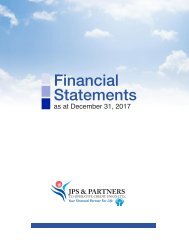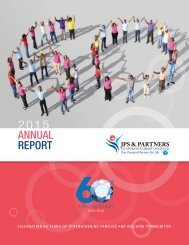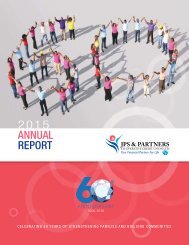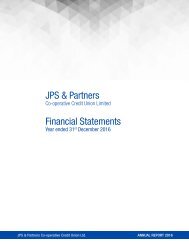JPSCU AR 2018 finan web
You also want an ePaper? Increase the reach of your titles
YUMPU automatically turns print PDFs into web optimized ePapers that Google loves.
NOTES TO THE FINANCIAL STATEMENTS<br />
For the year ended 31st December <strong>2018</strong><br />
(Expressed in Jamaican Dollars unless otherwise indicated)<br />
4. Financial Instruments & Financial Instruments Risk Management (cont'd):<br />
b) Liquidity risk cont'd -<br />
The key measures used by the Credit Union for managing liquidity risk is the GAP analysis and theratio<br />
of liquid assets to total savings deposits. For this purpose, liquid assets include cash and bank<br />
balances, deposits held with the Jamaica Co-operative Credit Union League (JCCUL) and highly liquid<br />
investments which have maturity up to nine months.<br />
The Credit Union is subject to a liquidity limit imposed by JCCUL and compliance is regularly monitored.<br />
This limit requires the Credit Union to maintain liquid assets amounting to at least 10% ofsavings and<br />
deposits. The liquid asset ratio at 31st December <strong>2018</strong> was 30.50% (2017 32.06%) which is in<br />
compliance with the standard.<br />
Items not carried on the statement of <strong>finan</strong>cial position<br />
At 31st December <strong>2018</strong>, theCredit Union's commitment toextend credit to its members in respect of<br />
loans approved but not yet disbursed, amounted to $14,629,199 (2017: $15,562,266).<br />
There has been nochange totheCredit Union’s<br />
manages and measures this risk.<br />
exposure to liquidity risk or the manner inwhichit<br />
The previous table summarises the net liquidity gap and thecumulative liquidity gap oftheCredit Union<br />
by analysing its assets and liabilities into periodical maturity categories. Members Voluntary Shares and<br />
other Savings deposits have no contractual maturity. The amounts included in the analysis<br />
are based on management’s estimate of expected cash flows on these instruments as determined by<br />
retention history. These may vary significantly from actual cashflows which are generally expected to<br />
maintain a stable or increasing balance.<br />
c) Market Risk<br />
Market risk is the risk that thefair value or future cash flows of a <strong>finan</strong>cial instrument willfluctuate as a<br />
result of changes inmarketprices. These arise mainly from changes ininterest rates, foreign currency<br />
rates and equity prices and willaffect the Credit Union’s income or the value of its holdings of<strong>finan</strong>cial<br />
instruments. The objective of market risk management istomonitor and control market risk exposures<br />
within acceptable parameters, while optimising the return on investments. Market risk exposures are<br />
measured using sensitivity analyses.<br />
There has been no change to the Credit Union’s exposure to market risks or the manner in which it<br />
manages and measures this risk.<br />
The foreign exchange rateshave steadily increased over the preceding eight months and the Credit<br />
Union's exposure to market risks has therefore fluctuated as a consequence.<br />
i) Foreign Currency Risk<br />
Currency risk is the risk that themarketvalue of, or the cash flows from <strong>finan</strong>cial instruments will vary<br />
because of exchange ratefluctuations. The Credit Union is exposed to foreign currency risk due<br />
to fluctuations in exchange ratesontransactions and balances that are denominated in currencies<br />
other than the Jamaica dollar. Balances in foreign currency represent a minimal portion of the<br />
entire investment portfolio (2.20%) and are monitored to ensure that they provide a net positive return.<br />
These funds are held for investment purposes only. It ensures that itsnet foreign currency exposure is<br />
kept toanacceptable level by buying or selling currencies at spot rateswhen necessary to address<br />
short-term imbalances.<br />
JPS & Partners Co-operative Credit Union 34

















